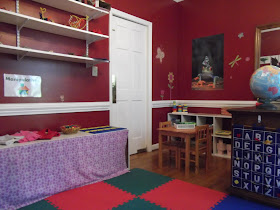I thought I would take a moment to share my centers with other teachers (or parents) who might be looking for ideas on how to put together an attractive and economical classroom. I've had a ton of fun putting these classrooms together. My
goal has been to make something beautiful and whimsical, but also functional. I hope you like them. :)
I have two rooms that I use for my school.
THE BLUE ROOM - The main classroom is what I call the "noisy room" and contains the dramatic play, blocks, art, and music centers.


DRAMATIC PLAY- The kitchen was a gift from Santa for my kids a year before I started the program. It is, by far, the most expensive thing in the room. The dress up clothes are hung up on command strip hooks. They're cheap and easy to move around. They can, and will, pull the drywall off your wall if pulled too hard as you can see in this picture. I will fix it...eventually. ;) I also use crates a lot to hold things. They're tough, cheap and don't look to bad when used sparingly. For the small figures, animals, cars trucks etc. I organized them into separate bins with labels I created using clip art.

ART - In my art center, I have an easel (one is all I have the room for) and a shelf full of art materials that the children have free access to: play-
doh and play-
doh tools, paper, markers, paints, recycled art materials, tape, white and colored glue, scissors, stickers, and of course, paper.If you look at the top of the image you will be able to see the little foil stars suspended from the ceiling. These cover the ceiling of the entire room. They are
simply stars cut from foil and hung using fishing wire.

MUSIC - My radio is the only thing off limits in the room, for obvious reasons, but the children have free access to a range of musical instruments. The larger instruments are on the shelf and the smaller ones are in the crate. They can also use headphones to listen to music if they wish. You can see on the side of the shelf where I took a page from a torn touch and feel book and taped it there for the children to enjoy. I actually took apart the entire book (after Olivia destroyed it), cut it up and taped the pages all over both of the rooms.

BLOCKS - I got these Melissa and Doug blocks (2 sets) with coupons at A.C. Moore. I just couldn't find a better deal anywhere else. The shelf is just a simple book shelf. I placed the blocks next to the dramatic play area so the blocks can be incorporated into the children's play with the small figures and vehicles.
THE RED ROOM - This room is called the red room for obvious reasons. It is also the quiet room. It contains the manipulative, reading, writing and science centers.

READING CORNER - This is my favorite spot in the whole school. This is where the children can go read a book or get away and snuggle with a stuffed animal. I created the space by turning my old china cabinet to the side and attaching a piece of cloth to the back. The couch is actually a toddler bed with a folded mattress pad on the bottom and pillows lining the back. The canopy is one that you would put over a child's bed.

WRITING - My writing center is simply my old coffee table with different sized markers, pens, various kinds of paper and
stencils on it. I used a Closet-maid shoe storage
cubby for mailboxes. Since my students are still at the
pre-reading level, each of their mailboxes is
labeled with their names and a symbol they each got to choose before school started. Children can recognize a simple symbol more readily than they can a name so they are able to tell who's box is who's, at the same time they are learning that written symbols can have abstract meanings.
 MANIPULATIVES
MANIPULATIVES - Manipulatives take up a large portion of the red room. This is probably because I don't separate them into math, language, etc. I have puzzles and games available in the china cabinet to the right of this shelf. My
manipulatives vary from Mr. Potato Head to Montessori's Pink Tower.
The children use the
manipulatives how they wish. If they want to build the tower from largest to smallest - great. If they want to put the blocks into cups and pretend they're tea - that's cool too.

I rotate the materials on low tables to
encourage the children to try new things and to keep up their interest. In this picture I have
magnablocks on the small table and number peg cards and dressing boards on the longer table. The shelf is for displaying artwork and setting art to dry.

SCIENCE - My science center is small. Really, the outside area is the best science center in my opinion. I also do a lot of science related projects with the children, but I have this center available to them all the time. In my science center, I keep plants, binoculars,
magnifying glasses and items for them to look at (shells, rocks, bark). I also have a kaleidoscope and some VERY cool magnets.










